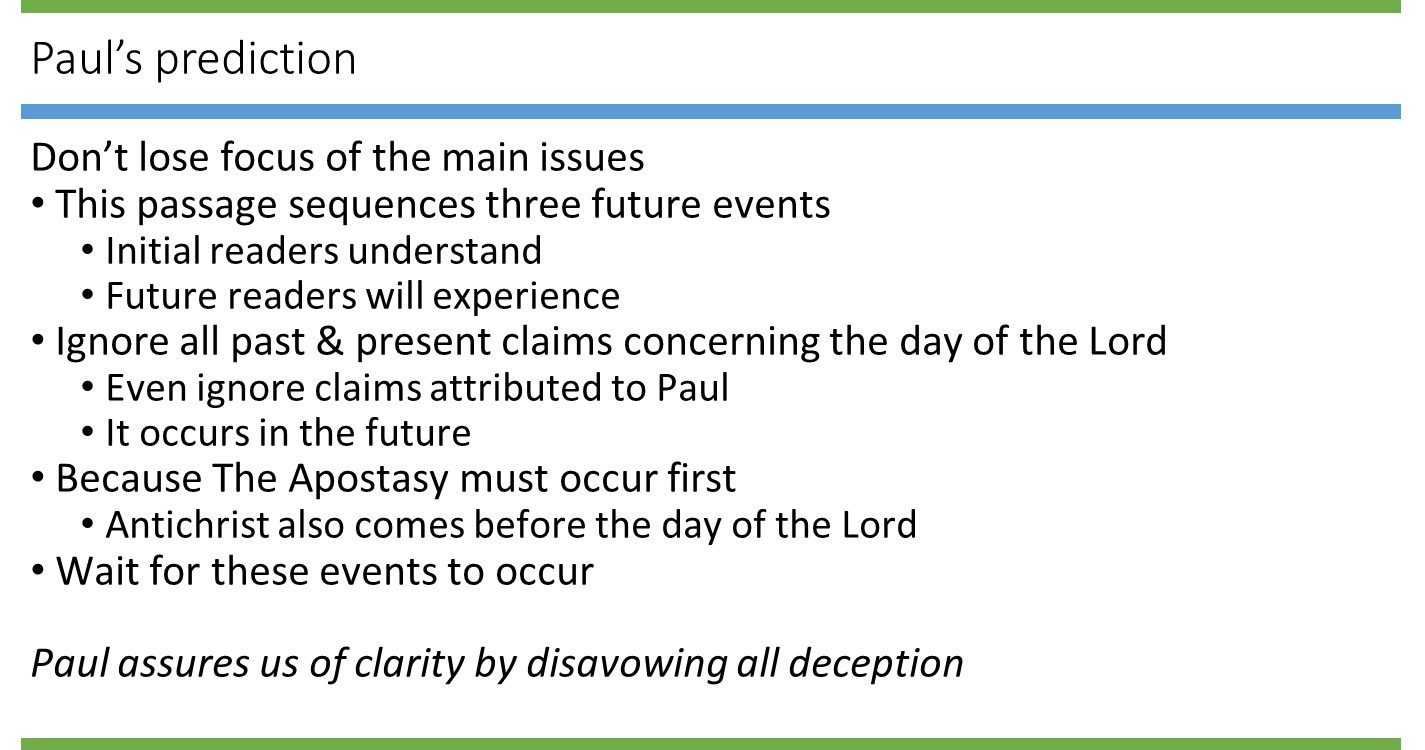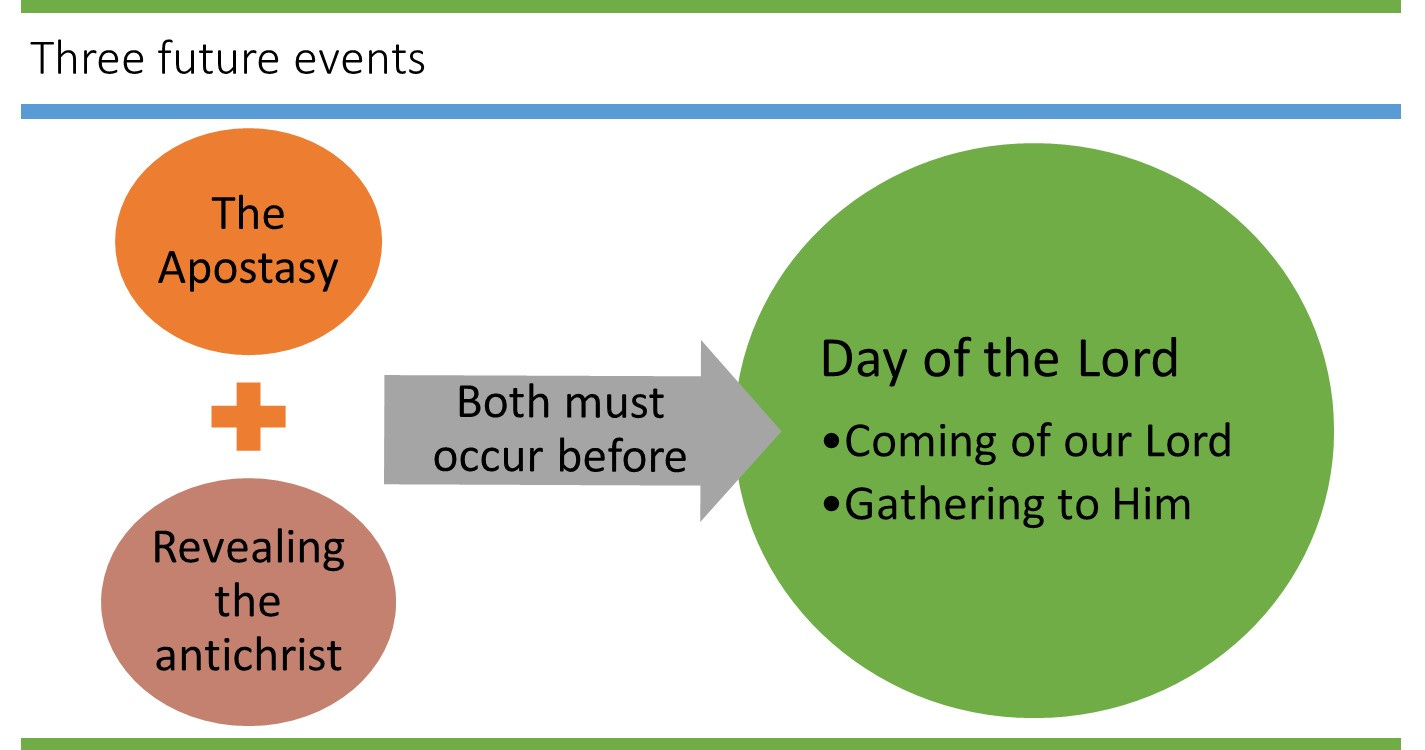[Continuing excerpts from chapter three of my new book - First Sign: beginning of the end- available on Amazon.com.
We learn about another sign of the end of the age. The Church will suffer a large withdrawl of people previously claiming the name of Christians. This happens all the time during this age, but the Apostasy will occur suddenly and in large numbers not seen in the past.]
Paul’s writings to Thessalonica reveal two end-of-age signs. He divulges The Apostasy (an event heralding the end of the age) and the revealing of Antichrist as leading to The Day of the Lord (the concluding event of this age) without attaching the word “sign” to them. Still, they have many features of the signs from chapter one.
This passage poses several problems for students of prophecy. The most important problem results from what’s missing. Paul never defines what he means by “apostasy.” He explains the revealing of the Antichrist in several verses, but merely mentions the other without further elaboration.
This leads to an interesting series of word studies. Paul uses the feminine form of “apostasy” in 2 Thessalonians 2 (Strong’s # G646). This noun occurs in just one other passage (Acts 21:20-21) so we need to expand our search to include other related words. We find the gender-neutral version (Strong’s # G647) in Jesus’ teaching about divorce. Strong relates this noun to its verb form (Strong’s # G868). Luke uses this word in Jesus’ parable of the soils, but Matthew and Mark use another verb in their versions of the same story (Strong’s # G4624). The noun form of that word (Strong’s # G4625) also helps us understand “apostasy.” Taken together, we have four additional Greek words we can use to learn about The Apostasy.
If that seems a little too technical (it’s Greek to me), you can get most of the same verses using English. Dust off that old dictionary or call up an online thesaurus tool and plug in “apostasy” or “apostate.” This approach lacks the same precision but will get you started. Your Bible may include some helps (footnotes and cross-references) to facilitate your study. I encourage you to find a Bible with these kinds of aids and use them. Learn through practice.
Paul’s prediction
We begin our study of The Apostasy with a clear passage from Paul:
Now we request you, brethren, with regard to the coming of our Lord Jesus Christ and our gathering together to Him, that you not be quickly shaken from your composure or be disturbed either by a spirit or a message or a letter as if from us, to the effect that the day of the Lord has come. Let no one in any way deceive you, for it will not come unless the apostasy comes first, and the man of lawlessness is revealed, the son of destruction (2 Thessalonians 2:1-3)
Paul guarantees the clarity of this passage by his expressed desire to prevent deception. Although Paul’s writing style adds extra phrases to modify and expand on his main point, he avoids encryption and encoding. His admonition “let no one in any way deceive you” includes Paul himself. He intends to reveal, not conceal.
Remain focused on Paul’s main points. He presents a sequence of three future events which his initial readers understand, and future readers will experience. He discounts any claims concerning The Day of the Lord’s premature arrival. He even prevents himself from altering this message. His reason comes from the order of events. Apostasy comes first.
Slide 33 Paul's prediction
I stress Paul’s intentions because many Christian authors interpret the meaning out of his writing. Without clear scriptural confirmation of their pet theory, they must find it or fit it into every contradicting Bible passage. The more far-fetched the theory, the more amplification used. After a sufficiently convoluted discussion, many readers have no idea that the author’s position contradicts the clear teaching of the Bible.
Three events
Paul speaks of three events in this passage: The Apostasy, the revealing of the Antichrist and The Day of the Lord. He stresses that The Apostasy comes before The Day of the Lord. I place the revealing of the Antichrist at roughly the same time as The Apostasy because Paul uses the conjunction “and” (Strong’s # G2532) to combine these two events (see Slide 34).
Slide 34 Three future events
Three events based on grammar
Paul mentions two clauses at the beginning of the passage: the coming of the Lord and our gathering together to Him. Some Christians teach that these phrases represent two distinct returns of Christ: 1) gathers believers to heaven and 2) brings them back to earth (see Slide 35). This reading imposes several grammatical, logical and doctrinal problems onto the passage. I have adopted the clearest reading, but since so many Christians interpret these verses differently, I feel the need to address their concerns. (I understand their concerns and arguments because I used to teach this view many years ago. But I have corrected my error after a long struggle.)
The phrase “with regard to the coming of our Lord Jesus Christ and our gathering together to Him” doesn’t stand alone. It modifies “the day of the Lord” as a description of that single event. In other words, The Day of the Lord consists of His coming and our gathering. The rest of the passage never refers again to this modifying phrase – only to The Day of the Lord.
To see this more clearly, try rereading the passage without this phrase. What do you lose? It explains The Day of the Lord, nothing more. Paul places it in the beginning of the passage to remind his readers of his new subject, not to introduce two more events. Their order of mention doesn’t override the “apostasy comes first” phrase which obviously stands as the clearest, most important timing indicator in the passage. That’s the point.
Three events based on “first”
I have heard this passage taught differently by proponents of a separate coming/gathering. One version counts the coming and gathering as two separate events (with “coming” matching The Day of the Lord). If so, then Paul put them in the wrong order. He should have said Christ gathers us first, then comes again at The Day of the Lord – an obvious problem.
Slide 35 Four events
In an alternative version, coming and gathering point to one distinct event which occurs separately and before The Day of the Lord (see Slide 35). If so, what does Paul mean by “the apostasy comes first?” Does it come before or after the gathering? If it comes after, then why attach “first” to The Apostasy? Paul should have said, “the gathering comes first.”
In another alternative, The Apostasy comes before the gathering (not shown), but this supports my view that the coming, gathering and day of the Lord all speak of the same event.
Some try to slip the gathering between The Apostasy and Antichrist. Silly!
Some critics of my view confuse the matter by confirming that they believe in a single return of Christ, but they split the second coming into multiple parts, phases, stages, etc. which occur over several years. I have heard this tactic expanded for up to seven “returns.” Don’t fall for these semantic games. The grammar is clear, but some won’t accept it.
Three events based on clarity
The passage clearly teaches the preeminent order of The Apostasy – it arises first. Also, Paul strongly emphasizes his warnings against deception. Given all this, why would he fail to clearly teach a separate gathering event? The terms appear in the text clearly enough, but not as a separate event or in the order portrayed by some experts. If Christ returns to gather us first, Paul misses a perfect opportunity to teach this order clearly. Instead, he flubs it. Plus, his warning against changes makes his mistake impossible to correct.
In my view, Paul gets it perfectly right, but theologians deliberately misread this passage to salvage their failing eschatology. Opponents who say, “It’s a mystery” only highlight the weakness of their view(s). Paul’s rejection of deception requires that he tells us everything candidly.
Three events based on intention
I began this discussion focusing on Paul’s intention for this teaching. What’s his point again? How we can confirm whether The Day of the Lord has come or not. He gives us two signs – The Apostasy and revealing Antichrist – so we won’t have to rely on potentially deceptive sources. Not only does an early coming miss his point, but it makes exactly the false narrative he refutes.
If everyone in Thessalonica rightly believed The Day of the Lord includes His return (and rule for 1,000 years on earth), they couldn’t make a mistake about when it comes. Just ask, “Where’s Jesus?” If we can find Him on earth ruling the nations, then we know The Day of the Lord has taken place.
Obviously, some people in this congregation thought Jesus might come and go without leaving any evidence of His return. Paul dispels this argument using The Apostasy and the revealing of antichrist. Yes, he could have used the Lord’s physical presence as proof (as I did), but his approach reveals something new. Two events occur before Jesus comes and gathers us.
Three events based on witness
We have studied hundreds of verses during this and my previous book – The Fourth Kingdom: Our place in God’s timetable. If Jesus gathers us before His return, the resurrection and the end of the age, this is the first we hear of it. No clue or hint of a separate event and dozens of contradicting passages.
Proponents of a separate gathering use this passage as their proof text, but as we have seen, their interpretation challenges the clarity of the text. The passage argues against a separate coming of Christ. After careful study of the Scriptures, I find that no other and no better proof of a discrete return exists in the Bible. So instead of finding unmistakable evidence stating two returns separated by three or seven years, we have a passage which describes two events leading up to the one second coming.
Slide 36 Coming and gathering








